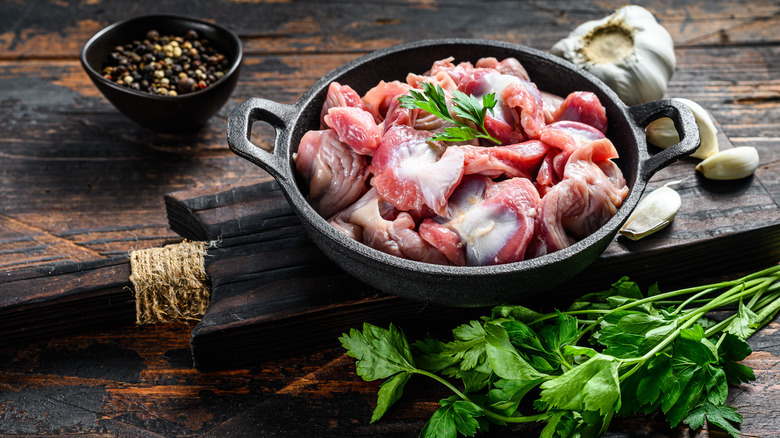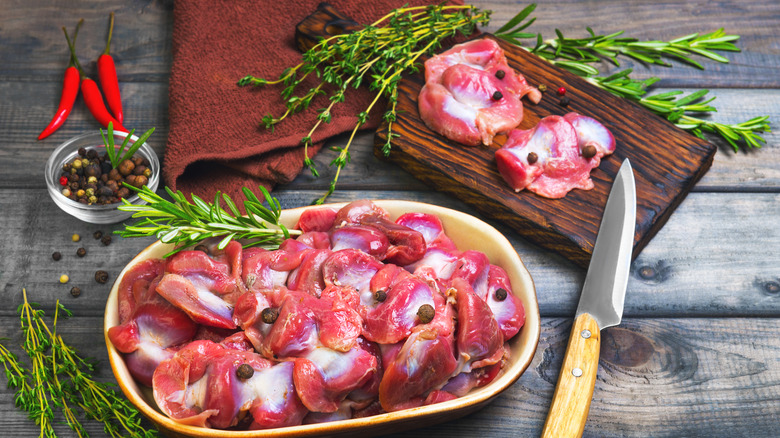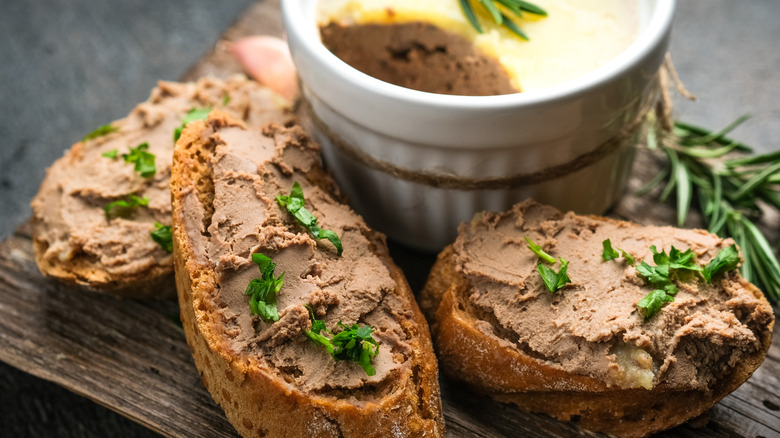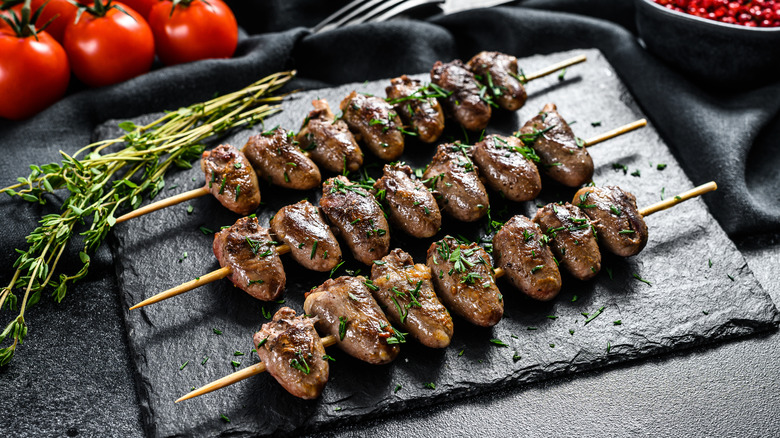Here's What Giblets Actually Are
You've probably heard of giblets and even eaten giblet gravy. You may have encountered the odd bag of what appears to be organs inside of your Thanksgiving turkey. But you may not know why they're there or what to do with them. In the past, whole chickens also came with feet, wing tips, and heads. Though these days, you will find just the liver, heart, and gizzard. You may also have noticed your whole chicken no longer comes with the bag of goodies. Consumers' lack of interest, use in pet foods, and factory farming have all played a role in the missing giblet bags (per The New Statesman).
Fortunately, chicken gizzards, liver, and hearts are likely available by the pound in your grocery store. It can be easier to buy a pound of liver to make pâté than save them one by one from six months of whole bird purchases.
Collectively, the organs are called giblets and can be used to fortify broth, make gravy, and they can make a savory addition to your poultry stuffing. They also have unique flavors and can individually be made into delicious and nutritious dishes.
What to do with gizzards?
So if you have been buying whole chickens and saving the giblets, which parts are which, and what do you do with them?
The gizzard is probably the most perplexing giblet for most. It is two small balls of meat attached with a thick layer of what looks like wrinkly skin. Even the name is a little off-putting. Still, they are packed with nutritional value. One cup of gizzards provides 44 grams of protein and 25% vitamin B12, 23% niacin, 18% riboflavin, 43% zinc, and 27% of the iron and phosphorus recommended for daily consumption (per DeLong's Gizzards & Poultry Processing Equipment).
They can be cleaned off the silverskin and made into perfect bite-sized pieces for frying or stewing (via Fowl Fortress Farms). But some recipes state to boil them whole, making gizzards much easier to prepare and seriously delicious (Kusina ni Lola). We recommend trying something unique, like Guineos con mollejas en escabeche, a traditional Puerto Rican dish of pickled gizzards and green bananas.
Liver is great for pate and so much more.
The liver is two shiny lobes of smooth offal with connective tissue and veining between them. The BBC states cleaning chicken liver is easy, explaining that connective tissues can be bitter or have an unpleasant texture. Healthline calls the liver "nature's multivitamin." Chicken liver is remarkably nutritious. Weighing in per ounce with 75% vitamin A, 79% vitamin B12, and 33% selenium of your recommended daily allowance. Those are just a few of its health rewards. It's also low carb, high protein, lower in fat than many types of meat, and is a non-fruit source of vitamin C (via Paleo Leap). It is also very versatile in the kitchen.
Pâté is an obvious recipe for livers, but they are also great when fried, sauteed, and served with scrambled eggs (per The New York Times). Though the Centers for Disease Control and Prevention (CDC) makes it clear you should cook all chicken to 165 degrees F, Chefs like Jacques Pépin continue to cook liver to just pink (per Bon Appetit).
The heart of the matter.
The heart is an oblong muscle with a fatty ring and the remnants of the connecting arteries and veins on one end. The organ meat tapers to a soft point. According to Healthline, chicken hearts contain an incredible 304% of the recommended daily allowance of vitamin B12, 50% of your daily iron, and 57% of the daily value of riboflavin.
Hearts are the easiest of the bunch to prep, just a quick trim of the veins that may be left on top. Just don't throw out that trim. Next, you can make the tasty, chewy Tokyo-style yakitori, hatsumoto. The rest of the heart, or hatsu in Japanese, can be grilled yakitori style as well, but these skewers are called yakitori baku (per The Yakatori Guy). Try packing a bite-sized pop of flavor and nutrients in your next stir-fry by adding chicken hearts (per Simple Chinese Food).
Eating all of the giblets is an excellent way to promote better food systems. Samantha Garwin from Fleisher's Craft Butchers proposes that our obsession with breast meat has led to inhumane farming practices. She tells Food Print, "By ensuring that nothing goes to waste, we are fulfilling our duties as conscious consumers, forging the final link in an environmentally- and socially-responsible supply chain."
Whether you're looking to bump up the flavor of your poultry stock or make more socially conscious food choices, the little bag of giblets in your bird is a culinary treasure.



